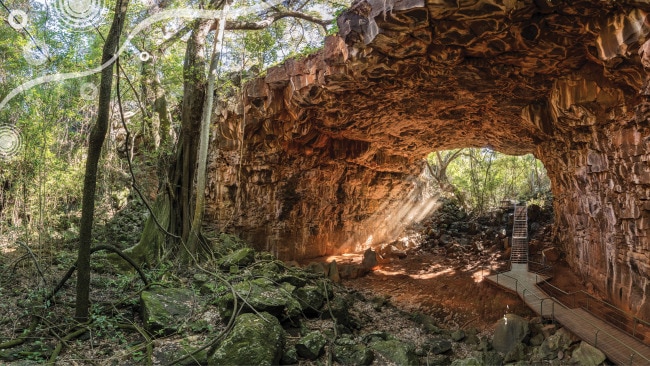Fail-proof ways to select a good, inexpensive red wine
WHEN it comes to red wine, most people love drinking it, but few enjoy buying it. Here’s how to find a good, inexpensive bottle.

IN THEORY, buying a good but inexpensive red should be fairly straightforward. In practice, it’s another story.
BRUSH UP ON THE BASICS
Can’t tell a shiraz from a cab sauv or a merlot from a pinot noir? There are a few simple rules to help.
“As a guide, shiraz should be full-bodied and rich and a little spicy with flavours of blueberries and plums. Cabernet sauvignon should taste of black cherries, baking spices and sometimes mint. Lighter styles like pinot noir and tempranillo look for things like cherries, raspberries and clove,” BWS head of wine Chris Mattes says.
Read this nifty guide to differentiating your reds here. [link through to Caitlin’s article, please]
UNDERSTAND WHAT MAKES A GOOD RED
The tricky thing about picking a good bottle is that it all depends on personal preference. One person’s nectar is another’s cat piss.
“A good bottle of red is going to be different to everyone. Everyone has a different palate,” Mr Mattes explains.
From a technical perspective, all wine is judged on its smell (if you stick your nose in the glass and take a whiff, does it smell fruity, or even floral?), balance (do the acidity, tannin, alcohol and fruit perfectly complement each other?), depth (can you taste layers of flavour?) and finish (the longer the flavour lingers on your palate, the better the wine).
“For me, I judge a good red by if you finish a mouthful, does it leaving you wanting more?” Mr Mattes says. “If you do, then it’s probably not a bad wine. It’s really that simple.”
He says lighter wines like pinot noir, tempranillo, malbec or grenache are great for people who are just starting on their red wine journey or who want to drink something instead of beer after knocking off work.
“These wines typically have bright, berry fruit flavours and are easy and approachable,” he says.
Preferences for grape varieties and regions rise and fall, shifting like the seasons of the fashion world. Pinot noir has been the talk of the town over the past couple of years in Australia.
“My next big bet is grenache. I think it’s going to be the new pinot,” BWS category manager James Maltman says. “A lot of the vineyards are putting down new vines and growing a lot more grenache. Some of the wines we’re seeing coming through are really nice and light.”
PRICE POINT
According to Mr Mattes, the $10 price point is crucial to landing yourself a good bottle, but around the $25 price point is generally a sure bet. This is where the level of excitement rises exponentially over $10 wines.
FIND A GOOD BOTTLE SHOPThe perks of the job for Rob Craske, manager of BWS Channel Court in Tasmania, are pretty obvious. He gets to sample a lot of bottles. Too many, if he’s being honest. For this reason, people who work at bottle shops generally know what they’re talking about, and they typically want return business.
“A good bottle shop will have staff who’ve tried the wines they recommend,” he says. “The shop owner should be asking you for your budget, what type of food you want to drink it with and what type of wine you usually like, so they can really find the bottle the customer wants.”
Bottle shops may seem intimidating, but they’re generally filled with nice people who love talking about wine. Plus, they’ll arm you with some impressive information you can regurgitate to your mates.
LOCATION, LOCATION
An easy way to get the most bang for your buck is by knowing what regions to look for, keeping in mind the best bottles will say they come from a recognised wine region like The Coonawarra or Margaret River rather than simply stating Adelaide or South Eastern Australia.
“Get to know some of the regions that are well known for producing good wines. The Margaret River, Barossa Valley, Coonawarra, Clare Valley and Yarra Valley tend to be higher quality rather than if they’re from a blend of regions,” Mr Maltman says.
TAKE NOTICE OF THE LABEL
Wine labels are designed to catch your eye in the sea of hundreds of look-a-likes, but grabbing the prettiest design is not always the cleverest way to shop.
“I don’t take notice of the artwork, but the first thing is I do read is the back of the label,” Mr Craske says. “Even though there’s the brand’s own information there, it will also tell you whether it’s full-bodied, or whiter, or what it might go with.”
You know those award stickers you see on wine bottles? Ignore them, he says.
“The number of medals that wineries put on their labels are not a good indicator of how good the wine actually is. Only the big wineries with enough money to spend on awards enter them.”
Bottles that stand out thanks to their fashionable design (I’m looking at you, beautifully wrapped Crafters Union) are great conversation starters, but choosing wine based on the label artwork won’t help you either way.
“In the old days, if a wine label looked pretty or something new, out-of-the-box or fresh, the wine generally was crap. But now, there’s a couple of really good wines like Take It To The Grave which has a striking skeleton artwork on the front cover, which is a really, really good wine,” BWS Newtown manager Tony Drew says. “At the end of the day, you’re better off getting a recommendation from the bottle shop owner. To pick from the label these days is very difficult.”
JUDGE THE BOTTLE
Pick the bottle up, check out how heavy it is.
“Look for a bottle with a good, heavy weight,” Mr Mattes says. “Generally good wine comes in a bottle that has got some quality about it. And it should have a deep indent at the bottom. Cheap bottles have a flat base.”
GET A BIT ADVENTUROUS
It is far too easy to fall back on the wines you’ve tried before and are familiar with. And for good reason; no one wants to land themselves a bottle of dodgy plonk. But going with a safe bet prevents the joy of discovery, plus your taste for wine is always developing. Bottom line: don’t be boring. Ask your bottle shop what’s weird; what’s new.
“Don't be afraid to try something new. Life’s too short to drink the same thing over and over again,” Mr Mattes says. “There are some really cool labels out there these days and labels do sell wines! Don't be afraid to try something quirky … it might surprise you.”
THE BEST OF THE REDS UNDER $25
Recommended by the experts in wine
SHIRAZ
Peter Lehmann The Barossan ShirazApprox price: $25
“Big, bold, typical Barossa shiraz. It’s nice, it’s good quaffing wine.” — Tony Drew, Newtown BWS
Jacob’s Creek Double Barrel Shiraz
Approx price: $20
“This is the red I usually recommend to everyone. Generally, I get two answers: Yes, they’ve had it, and they really enjoy it. Or, no they haven’t tried. They try it, they come back and they say, ‘That was sensational.’” — Tony Drew, Newtown BWS
PINOT NOIRSquealing Pig Central Otago Pinot NoirApprox price: $25
“It tends to be softer and more fruity than those from Tasmania or the Yarra Valley. The softer tannins of a pinot mean that it’s a lighter red to drink and contains nice cherry, fruity characters.” — James Maltman, BWS category manager
Devil’s Corner Pinot NoirApprox price: $24
“A cracking wine out of Tasmania.” — James Maltman, BWS category manager
ORGANICFarm Hand Organic Cabernet SauvignonApprox price: $17
Drink with: Braised lamb shanks
GRENACHELittle Giant McLaren Vale GrenacheApprox price: $23
“This is a really good example of nice, light, easy-drinking grenache. It has an almost sweet, candy nature to it, as well as depth and complexity. It’s got a quirky bottle with a wombat on the front.” — James Maltman, BWS category manager
Cat Amongst the Pigeons GSM
Approx price:
“A really lovely wine out of the Barossa Valley” — James Maltman, BWS category manager
MERLOT
Elephant in the Room MerlotApprox Price: $17Drink with: Braised ribs and mushroom sauce
MALBEC
Macho Gaucho MalbecApprox Price: $21Drink with: This full-bodied Argentinian Malbec begs to be paired with big flavours of pepper, sage, creamy mushroom sauces, and punchy cheeses.
TEMPRANILLOLovers not Toreadors TempranilloApprox price: $24
“Lovely, lively cherry character to this Spanish wine. A lovely wine.” — James Maltman, BWS category manager
Hogs in the Woods TempranilloApprox price: $17
“This is a good example of an Australian tempranillo. Nice, light fresh style. A little bit stronger than a grenache. A bit like pinot: something you can chuck in the fridge for 30 minutes to take the edge off.” — James Maltman, BWS category managerCABERNET SAUVIGNON
Grant Burge Barossa Ink Cabernet SauvignonApprox Price: $20Drink with: The intensely chocolate and berry flavours complement a roast.



